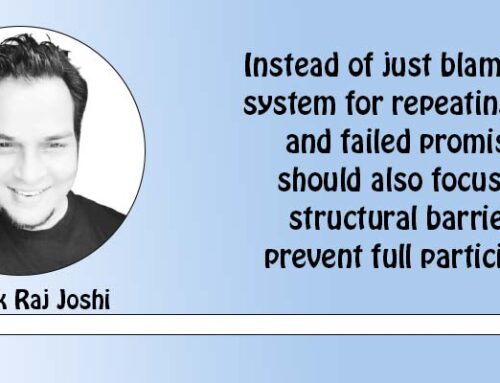Deepak Raj Joshi
Cyberbullying affects 17 percent of the world’s families. Almost one in five parents in the world admits that at least one of their children has experienced cyberbullying. It is a type of harassment that occurs between minors in which digital media are used to harm the victim, consciously and repeatedly over time.
The biggest difference between cyberbullying and real-life harassment is that the victims of cyberbullying have nowhere to hide which is why cyberbullying is insidious. Forwarding private IM communication to others, disguise spreading rumors, posting embarrassing photos or videos using websites or blogs, sending an abusive text to cell phones, sending threatening emails and pictures via email or mobile intending to harming others are different types of cyberbullying.
Threats, Harassment
Cyberbullying (The term is used as electronic harassment.) refers to deliberate insult, threat, or harassment by other modern means of communication – usually for a longer period. Cyberbullying takes place either on the Internet (for example, via e-mail, instant messaging, such as ICQ, on social networks, through videos on various portals) or over the phone (for example, via SMS or annoying calls). Often the culprit acts anonymously, so the victim doesn’t know who and where the attacks came from.
The number of Internet users is growing day by day. In 2021, it exceeded 5.2 billion. With such a large number of users, cyberspace is an ideal place for criminals. Our latest data show that there are 4.20 billion social media users around the world at the start of 2021, equating to more than 53 per cent of the total global population.
Despite this, we are ranked 147th in the Human Development Index. We have 23.92 million people using the internet and the number is growing. As of January 2021, we have the following social media use trend. Facebook 88.49%, Twitter 5.42%, YouTube 3.53%, Pinterest1.66% Instagram, 0.41%, LinkedIn 0.33%, etc. Based on the Nepal cyber bureau data, we have the following cybercrime in Nepal. Morphing social media photos to extort victims(editing the picture and posting on the internet), Revenge porn, (publishing Obscene photo and video online), Ransomware attack (asking Ransom after having all information under your control), Defamation Imposter (using another person’s name and photo on a social network, opening a profile page to insult and hurt), Hacking, Unauthorized access, Website defaces, Brute force attack (certain techniques to test password combinations to discover the credentials), SMS threat, hacking Facebook ID and using eSewa to collect money from relatives and friends.
Nepal cyber bureau has registered 357 cases in 75-76, 2301 cases in 76-77, and 1567 cases in 77-78 since the establishment of the Bureau. The total number of registered ICT-related cases is 4225. These are just a fraction of cases. Most of the cases go unreported due to social pressure.
Cybercrime
Social media profiles give people the freedom to post pictures of whatever they want. They can post photos of themselves, information about their interests, or updates about their location that give cyber bullies a chance to have fun by directing them to specific aspects of a person’s life. Cybercriminals can remain anonymous accessing personal information that we knowingly or unknowingly disclose online.
Cybercrime is a complex psychological nuisance in this age of the internet. As technology and the internet play a major role in our lives today, Its victims are people of almost all ages. However, adolescents and women are the most affected by cyberattacks.
We do have different legal acts ( the Electronic Transactions Act, 2008, The Children’s Act, 1992, The Copyright Act, 2002, The Individual Privacy Act, 2018) to protect citizens from ICT-Related crime. Having all these laws is not enough. We need comprehensive laws, and the most important thing is to have the awareness to protect citizens from cyberbullying and ICT-Related crime.
All social media accounts have block options. You can block him if there is initial bullying or if he speaks inconsistently and incoherently. If bullying becomes a major threat, which can lead to physical assault, death threats, or major defamation, the help of the nearest police station should be sought immediately. Netizens are now facing various problems on social media However, this issue remains unpublished. Only 28 per cent filed complaints alleging online torture. The rest are afraid that if they complain, they will be socially degraded.
Experts say that these incidents are happening again and again due to lack of control over emotions, loss of the relationship in trivial incidents, lack of proper idea about digital platforms. However, they think that many such incidents can be reduced only by controlling emotions.
cyberbullying has serious consequences and can affect anyone in many ways. It causes Emotional distress(Anger, frustration, shame, sadness, fear, depression), It interferes with schoolwork or job performance. cyberbullying will force people to quit a job, dropping out of school, changing schools, procrastination, violence, encourage them to use drugs, encourage Possession of weapons, and sometimes push people to commit suicide.
We can minimize cyberbullying by keeping the profiles of the social networks in private mode, Use passwords with a high level of security (2 step verification), knowing about the usage policies published by each digital platform, Using block function, etc.
Awareness
You should have to good antivirus, internet security, and a firewall. you should be careful when sharing information and you should not respond to provocations by a possible harasser. You should share concerns with friends, parents, or even third parties and save everything that is considered possible evidence of cyberbullying for future legal purposes.
Social media and technology come at a cost. We should not underestimate the power of technology. This will make and break society. We have to have a greater awareness of how ICT works and how we can protect ourselves and our families.
(A telecommunication engineer, Joshi is currently managing director of New Millennium College)
source: The Rising Nepal 14 May, 2021




